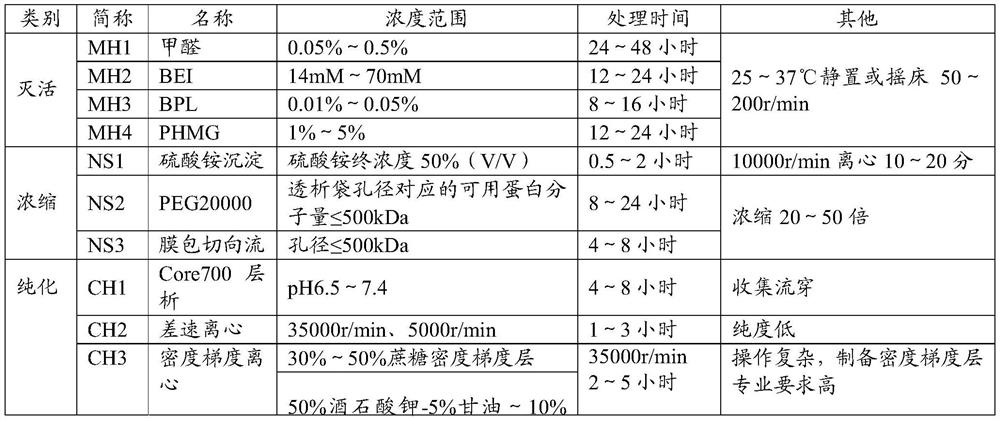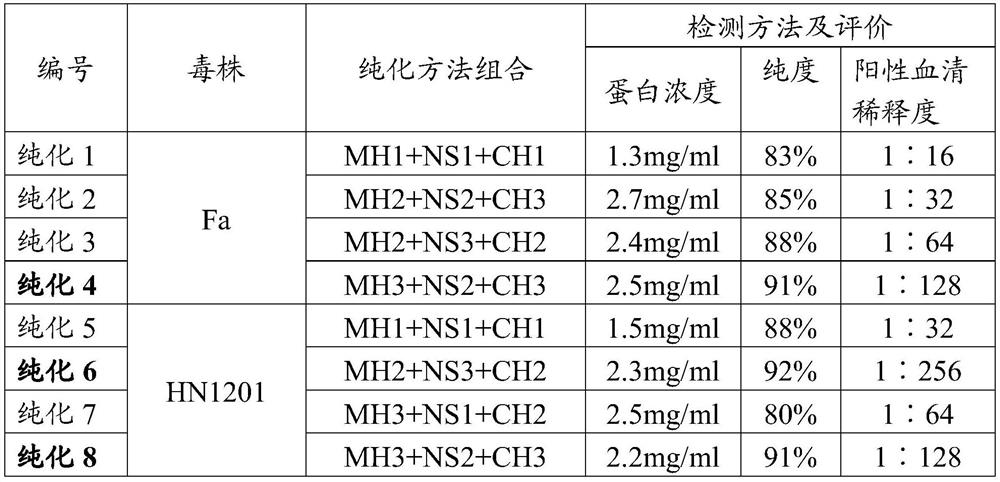Coating antigen, enzyme-labeled antibody and blocking method kit for detecting porcine pseudorabies virus ge antibody
A technique for porcine pseudorabies and a kit, which is applied in the field of biomedicine, can solve the problems of poor specificity of results, false positive results, false negatives, etc., and achieves the effects of favorable purification, good specificity and high sensitivity
- Summary
- Abstract
- Description
- Claims
- Application Information
AI Technical Summary
Problems solved by technology
Method used
Image
Examples
Embodiment 1
[0052] The preparation of embodiment 1 porcine pseudorabies virus antigen
[0053] 1.1 Selection of strains for antigen
[0054] Select representative strains among the two types of porcine pseudorabies virus strains to culture and proliferate to obtain their virus liquid, for example: the classic strain is the Fa strain, purchased from the China Veterinary Drug Control Institute; the variant strain is the HN1201 strain.
[0055] 1.2 Porcine pseudorabies virus inactivation, concentration and purification methods
[0056] 1.2.1 Inactivation method
[0057] Inactivation methods include: formaldehyde inactivation method (MH1 for short), formaldehyde concentration range 0.05%-0.5% (v / v), standing at 25-37°C or shaking at 50-200r / min, inactivation time 24-48 Hours; Diethyleneimine BEI inactivation method (referred to as MH2), BEA first 2 hours of cyclization treatment, virus inactivation is preferably in the concentration range of 14mM ~ 70mM, 25 ~ 37 ° C shaker 50 ~ 200r / min, in...
Embodiment 2
[0068] Embodiment 2 Preparation and identification of monoclonal antibody and enzyme-labeled antibody
[0069] 2.1 Preparation and identification of monoclonal antibodies
[0070] 2.1.1 Preparation of monoclonal antibody 11H1
[0071] Preparation of immunogen: The Fa strain with the best evaluation effect in Example 1 was purified to obtain 2.5mg / ml, 91% antigen after purification, HN1201 strain obtained through purification 6 and 8 respectively, and purification 4 and purification 6 A total of 4 immunogens were prepared by combining the mixed antigens of the classic strain and the variant strain.
[0072] Hybridoma preparation: see Ed Harlow et al., "Antibodies A Laboratory Manual", Cold Spring Harbor Laboratory 1988. First, the four immunogens were immunized with multi-point intraperitoneal and back subcutaneous injections at intervals of 2 weeks for 6-8 days. Week-old female Balb / C mice were mixed three times (50 μg / mouse, mixed with the same amount of Freund's complete adj...
Embodiment 3
[0113] Preparation and detection method of embodiment 3 kit
[0114] 3.1 Preparation of the kit
[0115] Antigen-coated plate: use CB buffer to separate the single antigen prepared by purification 4, purification 6, and purification 8, the mixed antigen prepared by purification 4 and 6, the mixed antigen prepared by purification 1 and 5, and the gE recombinant protein antigen respectively Dilute to a final concentration of 1 μg / ml for coating, 100 μl / well at 2-8°C for 16-24 hours, add 150 μl / well with 3% skimmed milk powder PBS solution, block at 2-8°C for 16-24 hours or at 37°C for 2 hours, discard the blocking solution and store at 2-8°C for later use.
[0116] Enzyme-labeled reagent: Take PBS solution, 200ml of fetal bovine serum, 4mg of AM dye, mix well, and add PBS to make the volume 1L. Dilute the enzyme-labeled antibody with the above solution at a final titer of 1:10000, filter through 0.22 μm, and aseptically dispense.
[0117] Sample diluent: take PBS solution, 20...
PUM
 Login to View More
Login to View More Abstract
Description
Claims
Application Information
 Login to View More
Login to View More - R&D
- Intellectual Property
- Life Sciences
- Materials
- Tech Scout
- Unparalleled Data Quality
- Higher Quality Content
- 60% Fewer Hallucinations
Browse by: Latest US Patents, China's latest patents, Technical Efficacy Thesaurus, Application Domain, Technology Topic, Popular Technical Reports.
© 2025 PatSnap. All rights reserved.Legal|Privacy policy|Modern Slavery Act Transparency Statement|Sitemap|About US| Contact US: help@patsnap.com



